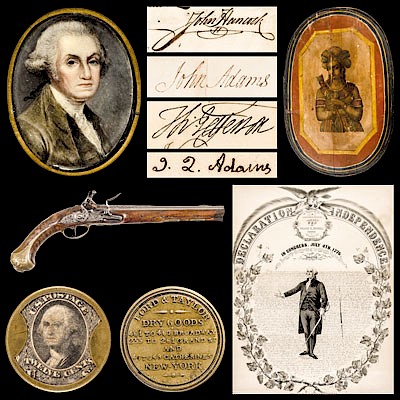Rare 1856 DECLARATION of INDEPENDENCE Lithograph Engraving by J.H. Bufford
Lot 178
Estimate:
$4,000 - $5,000
Absentee vs Live bid
Two ways to bid:
- Leave a max absentee bid and the platform will bid on your behalf up to your maximum bid during the live auction.
- Bid live during the auction and your bids will be submitted real-time to the auctioneer.
Bid Increments
| Price | Bid Increment |
|---|---|
| $0 | $10 |
| $200 | $20 |
| $300 | $25 |
| $500 | $50 |
| $1,000 | $100 |
| $2,000 | $200 |
| $3,000 | $250 |
| $5,000 | $500 |
| $10,000 | $1,000 |
| $20,000 | $2,000 |
| $30,000 | $2,500 |
| $50,000 | $5,000 |
| $100,000 | $10,000 |
| $200,000 | $20,000 |
| $300,000 | $25,000 |
| $500,000 | $50,000 |
About Auction
By Early American History Auctions
Jun 1, 2019
Set Reminder
2019-06-01 12:00:00
2019-06-01 12:00:00
America/New_York
Bidsquare
Bidsquare : Historic Autographs, Colonial Currency, Political Americana & Revolutionary War Era
https://www.bidsquare.com/auctions/early-american-history-auctions/historic-autographs-colonial-currency-political-americana-revolutionary-war-era-4152
Historic Autographs, Coins, Currency, Political, Americana, Historic Weaponry and Guns, John Adams, Thomas Jefferson, Early American History Auctions auctions@earlyamerican.com
Historic Autographs, Coins, Currency, Political, Americana, Historic Weaponry and Guns, John Adams, Thomas Jefferson, Early American History Auctions auctions@earlyamerican.com
- Lot Description
American Revolution
1856 "DECLARATION of INDEPENDENCE" Lithograph Engraving by John Henry Bufford Boston
(DECLARATION of INDEPENDENCE) by JOHN HENRY BUFFORD, historical Lithographer in 19th-century Boston, Massachusetts.
1856 Excellent rare design Lithograph Engraving titled, "DECLARATION of INDEPENDENCE" by John Henry Bufford, Framed, Choice Very Fine. This very rare, ornate and superbly designed historic Lithograph measures 19.5" x 25.5" (by sight), framed to an overall size of 24" x 30". It is based upon an original pen and ink design by Gilman R. Russell. At its top is an American Eagle holding 2 Quill Pens and a banner that reads: "DECLARATION of INDEPENDENCE". Under the banner is additional text which reads: "Designed and Executed Entirely in Pen by Gilman R. Russell, Teacher of Practical, Plain, and Ornamental Writing and Drawing".
Other design features include an "All Seeing Eye" all within a floral border. Below that is the text of the Declaration of Independence, along with a wonderful large image of George Washington, shown standing with his right arm outstretched, holding his sword in his left hand. A decorative floral border also surrounds the lower portion of this Engraving. There is some faint scattered unobtrusive tone, and a thin 9" vertical black ink run (as made from the press) to the right of George Washington. This is the first example of the 1856 Bufford Engraved Declaration of Independence, after Russell. It is unique in style and design, highly decorative with nice attractive eye appeal, ready to hang on display.
John Henry Bufford (1810-1870) was a Lithographer in 19th-century Boston, Massachusetts. Bufford had trained in the Pendleton shop in Boston from 1829 to 1831.
In 1835 he moved to New York, where he "worked independently for five years while accepting commissions from George Endicott and Nathaniel Currier." Bufford returned to Boston in 1839, and became "chief artist" in the print shop owned by Benjamin W. Thayer (who had bought the Pendleton outfit)."
By 1844, the shop's name changed to J.H. Bufford & Co. (1844-1851)." By one assessment, "Bufford's firm produced lively, accomplished images in many forms, including sheet music, city views, marine views and landscapes, book illustrations, reproductions of paintings, commercial depictions of factories, and contemporary genre views; ... [and] lithographic portraits copied from daguerreotypes."
Artists who worked for Bufford included Francis D'Avignon and Leopold Grozelier. In the 1840s-1860s Bufford lived in Roxbury and worked on Washington Street, Boston
- Shipping Info
-
Early American provides in-house worldwide shipping. Please contact us directly if you have questions about your specific shipping requirements.
-
- Buyer's Premium



 EUR
EUR CAD
CAD AUD
AUD GBP
GBP MXN
MXN HKD
HKD CNY
CNY MYR
MYR SEK
SEK SGD
SGD CHF
CHF THB
THB














